Around a small table in Cindy Sherman’s New York studio, there are a dozen mannequin heads crowding in to face us as we talk. Some wear hairpieces and some don’t. It is tempting to think of Sherman’s own face in among them as a 13th wig stand. Slight and pale and unmade-up and now 62, with her blond hair tied back, she has been her own artist’s model and blank canvas for more than four decades, the original shape-shifting selfie queen. A flick through the photographs in her current retrospective exhibition in LA reveals her transformed into 20 kinds of matinee starlet, Hitchcock lead, pneumatic Monroe, terrified centrefold, crime-scene corpse, old master muse, cut-up sex doll, Republican wife, clown; both as determinedly absent and iconically present in her work as Andy Warhol once was in his.
In her first new pictures for five years, Sherman, the face that launched a thousand gender-studies PhDs, has cast herself as the ageing Hollywood diva, channelling Gloria Swanson and Bette Davis and Greta Garbo. In glorious 1960s Technicolor, she vamps it up in turbans and pearls on chaises longues, staring into the middle distance through layers of kohl and unlikely eyelashes. Sherman has become the consummate survivor.
The divas came to life over the past year or two in this room on the 12th floor of a building in west SoHo. Sherman has received just about every award available to an American artist, including a MacArthur fellowship “genius grant”; she has twice represented her country at the Venice Biennale; her original 1980s “film still” photographs have sold for more than $4m. Still, all of that one-woman industry begins, she says, as it always has since her make-believe began as a child, with just “the look of a wig or the feel of a piece of material”.
Being in Sherman’s studio inevitably feels a bit like being inside a dressing-up box. There are racks of silk gowns and shelves full of false nails and false eyebrows and prosthetic flesh and horror masks. She fossicks in thrift stores and yard sales for furs and costume jewellery. The studio gives on to her kitchen and living room, blurring the lines between her life and work. “I’m not a nine-to-five kind of artist,” she says. Sometimes she doesn’t come into the studio for days; sometimes she is trying on other lives for size until the early hours.
In the middle of all the props and in the centre of the room are the lights and cameras and mirrors and the green-screen backdrop that allow Sherman to perfect her uncanny illusions. The ghosts of some of those conjured characters seem to inhabit the space. Looking at her piles of source material and cuttings, you half expect her to announce as the old impressionist used to: “And this is me”.
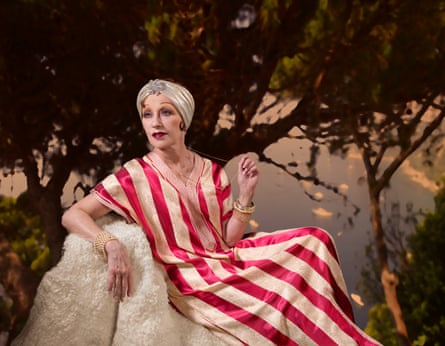
In person, she is a quiet, slightly uncertain but welcoming presence, quick to smile, doing her best to get her mid-morning mind around my questions. We talk for a while first about techniques and strategies. About the revolutionary way that advancing technology has allowed her to expand the canvas of her own face, in the current show, to the size of a wall. About her excitement at a new printing process that “cooks a layer of ink on to the metal”, making her newest pictures seem like lightboxes, glowing from within.
Sherman’s work has developed a long way from the original scene-stealing 1980s stills from films never made that quickly became her unsettling signature. In the decades following that early success, it often seemed that she was wilfully trying to destroy expectations. In her “disasters and fairytales” (1985-89), she exhumed all kinds of horror using fake limbs and plastic boobs; subsequently, things got even more grotesque, with lavish photographs featuring fake vomit and rotting food. (That period was, she says now, a direct challenge to the art market that had appropriated her as its latest squeeze. “I was like, do they really like the work? Well, let’s see them put this over the dining table – I had fun making those pictures.”)
All the time, she says, she was “working my way out of the photographs: I went from being a reflection in a mirror to a fuzzy figure in the background to a body lying beside ants and fake blood. And then I was completely out of the photograph when I was using these mannequins and dolls and so on.” She was, she says, “questioning all the time, why am I in these photos? What is my need for that?” Part of the answer to that question, she suggests, is that she has often felt she has no option.
When she has finished a series of pictures, she sometimes needs to escape them for a year or two. “But then the need comes back very strongly. Usually it is so draining, the solitary effort of it, that after a few months of it I need to get out of this room.”
During those months she doesn’t let up? “Yes, I mean to the extent that if I do go out when I am working, to an opening or something, I literally find it extremely hard to talk. I am so much in my head.”
I’m interested to know why her current photographs return her altered image to centre stage, in the more direct way that she was escaping from for much of that past. Partly it is to do with the emotional aspects of ageing, her sense of mortality. She has, she says, come through a “few rough years” and, like the heroines she inhabits, lived to tell the tale.

Some of these issues – “health and just getting older” – took her by surprise a little. “A few years of not shooting and then switching over to a higher resolution camera really brought it home to me,” she says with a smile. “Now it is not like adding wrinkles to look older; it is using the wrinkles I already have to say something else. What is disturbing is not seeing more lines on my face but seeing that the range of possibilities of what I can do is much more limited. I guess I could go for looking like I was 100 if I wanted to, but looking younger than 50 is now a stretch.”
She wants her pictures to embrace that fact; elsewhere, she has talked about how she admires the determination of 61-year-old academic Mary Beard to appear on television looking how a 61-year-old woman looks. “I think my work has often been about how women are portrayed in the media,” Sherman says, “and of course you don’t actually see that many portraits of older women or old women in fashion and film. So that’s part of it.”
In some ways, Sherman has been waiting all her life to get to this point. Her dressing up started early. There are pictures of her as a girl of 12 already wanting to know how it might feel to be old, bent over and disguised by thick prescription glasses, an old sun hat, her stockings bunched around her ankles. Now she is approaching pensionable age, it is with a sense of defiance and curiosity. She lives on her own these days or, as she says, “with my bird” (a 25-year-old macaw); happily so, she insists, after a string of not always happy romances, including a long love affair with the singer David Byrne, which ended four or five years ago.
I mention that I was reminded, looking at her photos, of Eve Arnold’s famous pictures for Life magazine of Joan Crawford, going through her beauty routine in her declining years. She suggests it was just this kind of spirit she was trying to get at. “Sometimes it was just a photo I’d found,” she says. “You’d see someone wearing a tiara upside on her head or something and the extraordinary makeup.” In the recent past, she has transformed herself into a series of middle-American wives and ex-wives, Botoxed and wearing the marks of surgical enhancement like scars of war; the current pictures are more dignified.
How much does she want them to tell a particular story? I wonder. “I want there to be hints of narrative everywhere in the image so that people can make up their own stories about them,” she says. “But I don’t want to have my own narrative and force it on to them. And it shouldn’t seem so real that it looks like it was shot in a studio today. I want it to transcend time somehow.” The pictures begin to work, she suggests, to become affecting and estranging, when there is some ambivalence about them, rather than any kind of fixed emotion.
She wants her characters to take on a life of their own, like a novelist’s?
“Yes. Quite often I will do something and think, oh no, she looks a little too much like me. I have tried to learn not to be afraid of that when that happens. I am not trying to obliterate myself and completely hide within the images like I used to. I am a little more comfortable now in letting parts of myself show through.”
It has, you might say, taken her a long time to get to this point. Sherman grew up in suburban Long Island, the youngest of five children, with a nine-year age gap between her and the next sibling. “It was like I was an only child,” she says. “It was strange because it was like I wasn’t part of their family when I arrived because they had already existed for so many years before I came along.” The original impulse to dress up, she says, was born out of this anxiety. She adopts a girlish voice. “It was like: don’t leave me behind, you guys, remember I am still here!” She wanted to keep her family interested in her. “I thought: if you don’t like me like this maybe you will like me like this? With curly hair? Or like this?”
She worked out some of her fantasies in front of the TV. “There was a show that was called The Million Dollar Movie. Every day at the same time they would play the same movie. I watched King Kong over and over. And other schlocky horror movies, Japanese monster movies. I remember a little friend of mine, she was eight and I was 10 and she was scared of the monsters. I remember saying, ‘It’s OK, they are all fake.’ I would sit and draw from them or sculpt little things while I was watching TV. I have had a lifelong fascination with horror movies, scary movies, how they work.”
Sherman made her own suitably artful contribution to the genre with her only feature film, Office Killer, in 1997. And she persisted with her dressing up. “I think it took me a very long time to figure out who I am, what my needs were,” she says. “For a long time the characters were to ask those same questions: maybe this is who I want to be?”
To start with, after she came to live in New York, the dressing up was a way to conquer shyness. She would experiment with her face, making it up to look older or like a man’s. She turned up at parties in character, as a pregnant woman, or as Lucille Ball [the actor and star of 1950s US sitcom I Love Lucy]. Eventually, her lover and fellow artist Robert Longo encouraged her to photograph her transformations. New York in the 1980s seemed primed for her fluid identity.
The cliche of the city, I guess, is that it allows anyone to reinvent themselves – was that the attraction? “It was very strange,” she says. “I only grew up an hour away, but my family had this big fear of the city. The only times we would come in would be to go to Radio City Music Hall at Christmas. I never went to any museums, we had one art book in the house: The World’s 100 Most Beautiful Paintings. The most recent was by Salvador Dalí. I was scared of the city until I was done in college really. Then one day I was visiting New York and I saw the artist Vito Acconci just walking around SoHo. He had given a talk at my college and it suddenly struck me: that was a life you could live here.”
When she was making those early pictures, was there a sense of losing herself in the work?
“Not often,” she says. “But there have been times when I have just caught a glimpse of a reflection and thought: that is not me. That is somebody else. I love it when that happens. I am star-struck that this apparition has been created.”
Why does she think she loves that sense, which for some people might be alienating?
She suggests it goes back to her childhood again, in particular to her relationship with her parents. “Making these photographs [of divas],” she says, “I’ve reflected back on my mother. When she was my age she really seemed like an old lady. She was 44 when she had me, and back in the 1950s that was pretty old. My dad was 49 when I was born. They were as old as my friends’ grandparents and they looked like that too. My mother was like a martyr, a good person, but good almost to a fault. She would try to make me always be this good girl. When I was a teenager I rebelled somewhat, but it affected my adulthood in that I found it very hard to stand up for myself or to learn how to do that. I think I grew up deferring to other people. I think that was her always saying I had to be nice to people.”
And her father?
“He was stern but mostly he was just mean and bigoted,” she says. “He was just so selfish, couldn’t appreciate the family he had, the loving wife he had. It was ultimately more pathetic than anything. When we children got together after he died we found that the thing we missed most was telling each other the mean story that had happened to us that week: like what did he do to you? I would be like, ‘He wrote me this horrible letter.’ It was ridiculous, the things he would do.”
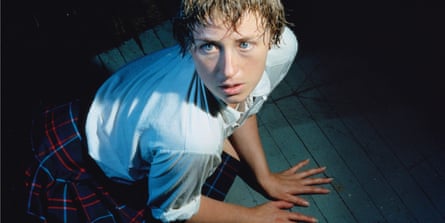
Some of Sherman’s desire to reinvent herself endlessly seems rooted in this autobiography when she talks, but it doesn’t quite seem enough somehow to explain the full compulsion of her work, the need in it. I have a sense that I get a bit closer to that need when I ask her in passing later in our conversation what her siblings did, whether they were artistic?
“No,” she says. “My sister got married when she was 16 and I was a baby when she left the house; she is 15 years older than me, she started a cooking school. I have no recollection of her or my oldest brother living at home. One brother killed himself when he was 27. My other brother, he is just retired now. He did computer stuff.”
How old was she when her brother took his own life?
“I was 15,” she says. “It was a very long story.” She pauses for a while.
It’s a hard age to deal with those emotions, I say. Was it around that time she decided she wanted to go to art school?
“Yes,” she says. “It was about that time.” And then thinking back nearly half a century, she bursts into tears. “I never really thought of art as being therapeutic,” she says, “but I guess it definitely was.”
Not quite sure how to respond while she wipes her tears and collects herself, I ask her if she has had conventional therapy.
“I have for the last 12 years or so,” she says. “It’s funny. My family was always dead against therapy, it was like, we don’t need any help! We are strong, we can get through things! And, boy, could they have used it… ”
Sherman goes on to suggest she has carried a lot of these issues into her relationships. She was married for 17 years to the video artist Michel Auder, who was addicted to heroin for much of that time. She believed she could help him overcome his addiction, but it did not work out like that. There was another ill-fated relationship with a film-maker called Paul H-O, which ended when he made an intrusive documentary, Guest of Cindy Sherman, about his dislike of being thought of in the art world as her inconsequential plus-one. Being single has liberated her, she believes.
“It’s a totally good thing for me,” she says. “I think my whole adult life I have been so afraid to be alone that if somebody acted as if they liked me a bit, I would be like, OK, you’re my new boyfriend. I am a very loyal person. I found it very hard to break up with people who I should have broken up with way earlier on in the relationship. I found myself in long-term relationships about which I now think: why was I with that person for so long? It seems ridiculous, almost shameful that you let yourself be hoodwinked in that way. I suppose – going back to the therapy session – that all goes back to my brother’s suicide. The fact that I couldn’t help him, maybe I can help this guy who can’t get his life together. So I made some very bad choices there. If only I had gone to a therapist earlier.”
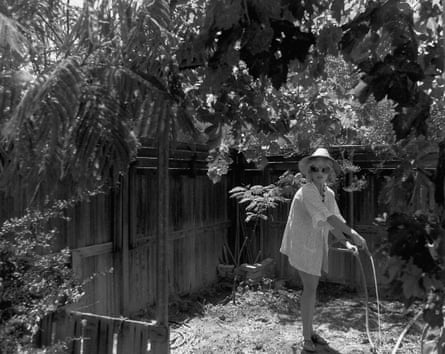
Some of that sense of “I will survive” liberation feeds into her diva images. “They are women who have gone through a lot and come out the other side,” she says. And then she wells up again and goes to get a tissue.
When she comes back, we talk a bit about the healthiness or otherwise of spending half your life looking in the mirror, the examined life, or at least the examined face. The process is second nature to her, she suggests, but still strange.
“It’s the one face you look at every day your whole life,” she says. “But of course you are looking at yourself in reverse so you never actually know what you look like. Photography can be similar. I remember an early boyfriend. I thought: he is just so handsome, and I would show a picture to somebody and they would not see it at all. In a still photo you only sometimes get the essence of a person. I have always been fascinated by why that happens.”
I suggest that one of the reasons her photographs continue to have their resonance is that they seem to have pre-empted an age in which self-dramatisation has become mandatory. We can all invent profile pictures and new digital identities on a daily basis. Could she see that coming when she started out?
She says not. She doesn’t really think of Warhol as a touchstone for her work either. “If anything I think I was coming out of the tradition of artists who used their own body, like Chris Burden or Bruce Nauman. That tradition of conceptual performance.”
Her own performances occur behind closed doors, though, and we only get to see the traces? “I did two live performances my first year out of college, both collaborations. I hated doing it. I was a hopeless collaborator because of course I always acquiesced to the other person’s usually bad ideas. Hence I always work alone. I never feel lonely. There is an aloneness to it. I have tons of friends; there is always someone to call.”
Does it feel strange, I say, these days to be studied in universities as part of art history, to have endless scholarly interpretations of what she puts together from her clothes rail?
“I don’t think about it,” she says. “Sometimes it feels strange at a gallery opening and I feel in awe of the sudden attention. Mostly when you start getting a response from people about new work you feel at least you have dodged another bullet and it’s OK.”
Before I go, she gives me a quick tour, pointing out one or two of her favourite lifelike dolls’ heads and curled Hansel and Gretel fingers for practising nail painting. On a wall are a gallery of pictures of smouldering silent film stars, the youthful versions of the pictures she has been making. I wonder if she sees it as an ongoing series, one that will age with her in the coming months and years?
“I think it might,” she says. “I like these characters. They have been through a lot. And I still have ideas where they could go.”
- Cindy Sherman: Imitation of Life is at The Broad, Los Angeles until 2 October
- Cindy Sherman is at the Queensland Gallery of Modern Art, Brisbane, Australia until 3 October
- Cindy Sherman and David Salle: History Portraits and Tapestry Paintings is at the Skarstedt gallery, 8 Bennet Street, London SW1, 1 Oct to 26 Nov; admission is free



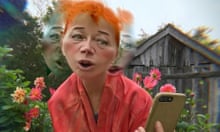
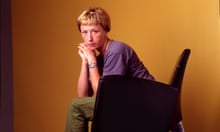
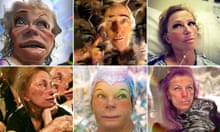
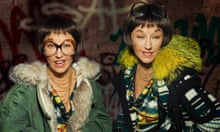

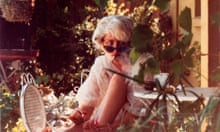


Comments (…)
Sign in or create your Guardian account to join the discussion